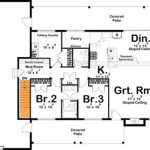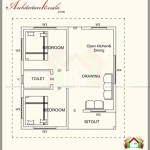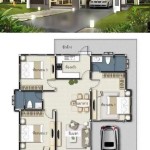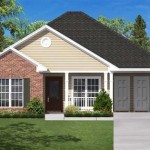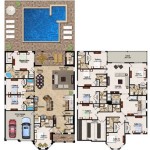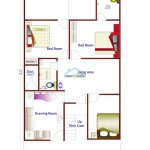4 Bedroom Cape Cod Floor Plans: A Comprehensive Overview
The Cape Cod style home, originating in 17th-century New England, remains a popular choice for homeowners due to its simplicity, functionality, and adaptability. A 4-bedroom Cape Cod floor plan offers ample living space and caters to the needs of families seeking a practical yet charming residence. This article will explore the key characteristics of 4-bedroom Cape Cod floor plans, discuss various layout options, and highlight design considerations for maximizing space and functionality.
The defining features of a Cape Cod home include a steep roof with side gables, a central chimney, symmetrical facade, and dormer windows. Originally designed to withstand harsh weather conditions, the Cape Cod style emphasizes efficient use of space and a minimalist aesthetic. These homes typically feature a rectangular footprint, often with a single story or a story and a half. The adaptability of the Cape Cod design allows for various configurations, making it well-suited for 4-bedroom arrangements.
Characteristics of a 4-Bedroom Cape Cod Floor Plan
A 4-bedroom Cape Cod floor plan generally incorporates the traditional elements of the style while providing the necessary space for a growing family. The layout typically features a combination of bedrooms on the first and second floors, maximizing both living area and privacy. The central chimney, while sometimes adapted for modern heating systems, remains a common architectural element. Key characteristics include:
*Symmetry and Balance:
The exterior of a Cape Cod home typically exhibits a symmetrical design, often with the front door centered and flanked by an equal number of windows on each side. This symmetry often extends to the interior layout, with rooms arranged around a central hallway or living space. *Steep Roof Pitch:
The steep roof pitch is a defining characteristic, designed to shed snow and rain efficiently. This design element also provides additional attic space, which can be utilized for storage or converted into living areas. *Dormer Windows:
Dormer windows are frequently incorporated to provide light and ventilation to the upper level. These windows add character to the exterior while expanding the usable space within the attic rooms. *Open Living Spaces:
Modern 4-bedroom Cape Cod plans often incorporate open-concept living areas, combining the living room, dining area, and kitchen into a single, unified space. This design promotes a sense of spaciousness and facilitates social interaction. *First-Floor Master Suite:
A significant trend in contemporary Cape Cod designs is the inclusion of a master suite on the first floor. This feature provides convenience and accessibility, particularly for homeowners planning to age in place. *Efficient Use of Space:
Cape Cod homes are designed for efficient use of space, with minimal wasted areas. The rectangular footprint and simple layout contribute to a compact and functional design. *Natural Light:
Thoughtful placement of windows, including dormers, is crucial for maximizing natural light throughout the home. This enhances the interior environment and reduces the need for artificial lighting.In a 4-bedroom configuration, one will often find two bedrooms on the main floor and two on the second. The layout may vary depending on the homeowner's preferences and the available square footage. A common modification involves converting the attic space into additional bedrooms, creating a more spacious and functional living environment.
Common 4-Bedroom Cape Cod Floor Plan Layouts
Several variations exist within the realm of 4-bedroom Cape Cod floor plans, each catering to different lifestyle needs and preferences. These layouts can be broadly categorized based on the placement of bedrooms and the configuration of living spaces:
*Two Bedrooms Upstairs, Two Bedrooms Downstairs:
This is a traditional layout that maintains a balance between the first and second floors. The master bedroom is typically located on the first floor, along with a second bedroom that can serve as a guest room or home office. The two remaining bedrooms are situated on the second floor, offering a degree of separation and privacy. *Three Bedrooms Upstairs, One Bedroom Downstairs:
This layout allocates the majority of the bedrooms to the upper level, creating a more private sleeping area. The master suite can be located either upstairs or downstairs, depending on the homeowner's preference. The first-floor bedroom often serves as a guest room or home office. *First-Floor Master Suite with Three Bedrooms Upstairs:
This is another very popular layout, especially in newer builds. It offers the convenience of a first floor master suite while providing three additional bedrooms upstairs for children or guests. This layout often features a larger master bathroom and walk in closet. *Expanded Cape Cod with Dormers:
This type of plan expands the usable space on the second floor by adding multiple dormer windows. This allows for larger bedrooms and bathrooms upstairs, and can even accommodate a second living area or playroom.Within each of these broad categories, variations exist in the configuration of living spaces. Some floor plans feature open-concept living areas, while others maintain a more traditional separation between rooms. The placement of the kitchen, dining area, and living room can be customized to suit the homeowner's lifestyle. Consideration should be given to traffic flow, natural light, and the overall sense of spaciousness when selecting a floor plan.
In some cases, homeowners may choose to modify an existing Cape Cod home to create a 4-bedroom layout. This often involves adding dormers to increase the usable space on the second floor or expanding the footprint of the home to accommodate additional bedrooms. Careful planning is essential to ensure that the modifications are in keeping with the architectural style of the home and comply with local building codes.
Design Considerations for Maximizing Space and Functionality
When designing or selecting a 4-bedroom Cape Cod floor plan, several considerations should be taken into account to maximize space and functionality. These include:
*Storage Solutions:
Cape Cod homes often have limited storage space, so it is important to incorporate creative storage solutions. Built-in shelves, closets, and under-stair storage can help to maximize space and keep the home organized. Attic spaces can also be utilized for storage, provided they are properly insulated and ventilated. *Natural Light:
Maximize natural light by strategically placing windows and skylights. Dormer windows are particularly effective at bringing light into the upper levels of the home. Consider the orientation of the home to ensure that the living spaces receive adequate sunlight throughout the day. *Open-Concept Living:
Consider an open-concept layout to create a sense of spaciousness and facilitate social interaction. This design allows for a seamless flow between the living room, dining area, and kitchen, making the home feel larger and more inviting. *Multipurpose Rooms:
Designate rooms that can serve multiple purposes. A guest room can also function as a home office or exercise room. This maximizes the use of available space and adapts to changing needs. *Efficient Use of Attic Space:
The attic space in a Cape Cod home can be converted into living areas, such as bedrooms, bathrooms, or a recreational room. This increases the usable square footage of the home and adds value. Proper insulation and ventilation are essential to ensure that the attic space is comfortable and energy-efficient. *Accessibility:
If the home is intended for aging in place, consider the inclusion of accessibility features, such as a first-floor master suite, wider doorways, and grab bars in the bathrooms. These features can make the home more comfortable and accessible for people with mobility limitations. *Outdoor Living Spaces:
Extend the living space by incorporating outdoor areas, such as a patio, deck, or porch. These spaces can be used for relaxing, entertaining, and enjoying the outdoors. A well-designed outdoor living area can enhance the overall enjoyment of the home. *Consider Climate:
When considering layouts take into mind the climate of the location where the build will be, specifically regarding insulation, heating, and cooling strategies. Proper insulation is crucial for maintaining a comfortable indoor temperature and reducing energy costs. *Local Building Codes and Regulations:
All modifications and additions to Cape Cod homes must comply with local building codes and regulations. Obtain the necessary permits before starting any construction work to ensure that the project is safe and legal. *Budget:
Set a realistic budget for the project and stick to it as closely as possible. Unexpected costs can arise during construction, so it is important to have a contingency fund in place.Ultimately, the ideal 4-bedroom Cape Cod floor plan will depend on the individual needs and preferences of the homeowner. By carefully considering the layout options, design considerations, and local regulations, it is possible to create a functional, comfortable, and aesthetically pleasing home that meets the needs of a growing family.

Cape Cod House Plan With 4 Bedrooms And 2 5 Baths 3047

Cape Cod Floor Plans Key Modular Homes

Cape Cod House Plan With 4 Bedrooms And 3 5 Baths 5423

Cape Cod Floor Plan 4 Bedrms 2 5 Baths 2405 Sq Ft 153 1066

Cape Cod House Plans With Gabled Dormers

House Plan 4 Bedrooms 2 Bathrooms Garage 3274 Drummond Plans

Cape Cod House Plans Find Floor And Designs

Cape Cod House Plan 4 Bedrms 1 0 Batj 564 Sq Ft 157 1618

Cape Cod Floor Plans Key Modular Homes

Pennwest Homes Cape Cod Style Modular Home Floor Plans Overview Custom Built By Patriot S

